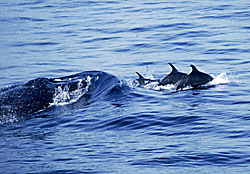![[Ocean Oasis Field Guide]](images/bnr-oo-field.gif)

![[Ocean Oasis Field Guide]](images/bnr-oo-field.gif) |  |
|
Tursiops gillii DELPHINIDAE (Whale Family) | |
DescriptionThe Pacific bottlenosed dolphin is frequently seen off the coast of Southern California. Adults are bluish-gray or purplish-gray on the dorsal side, and white on the belly to the anus. The flukes, flippers, and dorsal fin are blackish. The dolphin's head and snout are dark, with a relatively short, but well-defined beak, approximately 7.6 cm (3 inches) long. Size: Length to 3.7 meters (12 feet). Average weight of 200 kg (440 pounds). Range and HabitatRange: This species is found along the Pacific coast, from Southern California to the tropics. It has been reported as far north as San Francisco Bay. Habitat: Inshore waters, including esturaries and shallow bays. Natural HistoryBehavior: Bottlenosed dolphins commonly travel in groups of 50 or more individuals. They appear to communicate with one another through a series of grunts, whistles, clicks, pings, and other sonic and ultrasonic noises (Ingles, 1965). Dolphins have long fascinated humans, not only for their aquatic agility, but also for their seemingly altruistic behavior—dolphins have been observed caring for wounded and very young animals. Moreover, there are many records of dolphins voluntarily approaching humans, closely enough to be touched. Reproduction: Captive female dolphins appear to become sexually mature at 4 years. The breeding season occurs in spring and early summer. After a gestation of 12-13 months, a single calf is born. The calves are well developed and able to swim immediately after birth. Diet: Bottlenosed dolphins feed on a variety of fish, squid, shrimp, and crabs. They will often follow fishing boats to feed on discarded fish. They are very adept at using echolocation—projecting a sound beam and listening for the echo—to locate their prey. Conservation StatusThe bottlenose dolphin is protected in U.S. waters by the Marine Mammal Protection Act. Bottlenose dolphins are still generally plentiful in numbers, but are at or near depletion in some areas. |

Bottlenosed dolphins bow-riding Humpback Whale, photograph Pete and Gretchen Pederson
When a dolphin gives birth, a "midwife" dolphin will often attend. She helps the mother push the newborn to the surface for its first breath of air. The midwife also helps the mother protect the young from sharks for several weeks after its birth. |
Text by Linda West in consultation with Dr. Thomas Deméré.
Photograph © 2000 Pete and Gretchen Pederson
Field Guide |
Site Index |
Ocean Oasis Introduction
|
|
© 2000 San Diego Natural History Museum |